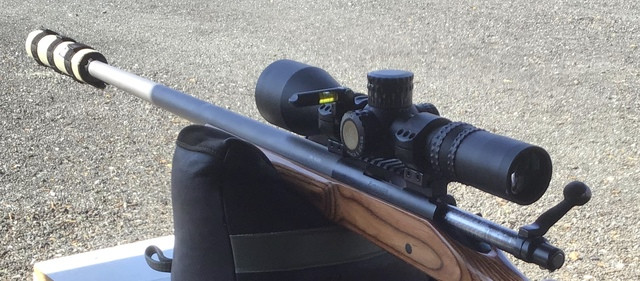But I do have one question that’s been in my head since reading this thread...how much error would a 20 MOA base cause if thrown into the equation. Would this type of base and say 1-2 degree Rifle cant make any difference in error at 1K yds? The scope would then be at a slight angle and not on a parallel plane with the rifle/bore. Please excuse my ignorance if this seems like a stupid question. Just curious.
JMD82
Whether you use a sloped base or not has no effect upon the issue. You are still going to sight in at some fairly close distance, like 100 or 200 yards.
The problem comes when you then dial up to shoot at LR, like 1,000 yards, because of one very hard rule of physics -- if your reticle does not point at the center of your bore then
with any amount you dial up (or hold over) your reticle's windage will be off. The bigger your scope-to-bore misalignment, the more your POI will be off from your POA. The more you dial up, the worse the error becomes.
The only way you can detect exactly how many MOA (or inches, or (
feet ) you are off at, say, 1,000 yards is to shoot at that distance on a dead-calm day and measure the error on your target. But to do that you have to hold the rifle exactly the same way when shooting at 1,000 as you did when you sighted in at 100.
So let's assume Lowlight can somehow do what no other person on the planet can do, which is to hold his rifle exactly level every time. He can't, of course, but let's assume for a minute that he can. He is still going to have a windage error when he cranks up from 100 yards to a longer range because he did not bother to make his reticle point at the center of his bore before he started the sight-in process. He did even try to do that, because he did not understand the importance of doing that. Indeed, he scoffed at the whole necessity.
So he will end up like the hundreds of other people I see every year, who find that when they start to accumulate LR dope, it does not contain merely elevation dope, but also windage dope. That assumes, of course, that you can hold your rifle the same way every time. Most people cannot without a reference (level on scope, plumb object downrange, etc.), but if you do use a level (or other reference) it will become very clear to you very quickly. The drift left or right from scope-to-bore misalignment usually starts to show up by 300 yards. It is quite apparent by 500 yards.
However, people like Lowlight will not see it as much because their cants are all over the place. They are just as likely to
correct their scope-to-bore misalignment by
accidentally canting the opposite direction as they are to magnify it by canting the other way. To them windage at LR is all a confusing jumble of "spend-drift," "coriolis effect" and "wind, even on dead-calm days" such that they just don't worry about it. Their approach is, you just fire a round or two at the LR target, see where you hit and then correct for it. Voila! They hit the target and consider themselves LR shooting experts.
And that is a perfectly acceptable approach for games. They should not, however, ever use the word "sniper" because true snipers do not have the luxury of firing "sighter" rounds. They need to hit the target with the first shot.
And anyone trying to do that without both a scope mounted to point at the center of the bore and a level on their rifle is at an extreme handicap. Anyone who purposefully omits both is a fool.
Because you are not going to experience the "1-2 degree rifle cant" you asked about -- it is going to be more like 10-20 degrees, especially if you are on sloping ground with no reference to look at. And unless you got lucky and accidentally canted in the direction needed to offset your scope-to-bore misalignment, your dope is going to say things like, "500 yards: 8.5 moa up and 2.25 moa right." Keeping "dual dope" like that is certainly one way to do it -- but I thought we were concerned about "time," and having to adjust two turrets every time the distance changes instead of one doubles that.
I don't understand why you would spend "hours" getting your scope aligned with your bore. I told you how to do it in 15 minutes, 30 at most.
I understand completely that your rifle, when aligned with the bore and level does not "feel right." But the question is, do you want to "feel good" or do you want to shoot straight? The solution, if the hold does not "feel right," is not to employ a consistent cant and keep windage dope, it is to (a) get used to it, or (b) get a stock that is comfortable even when the rifle is held level.



